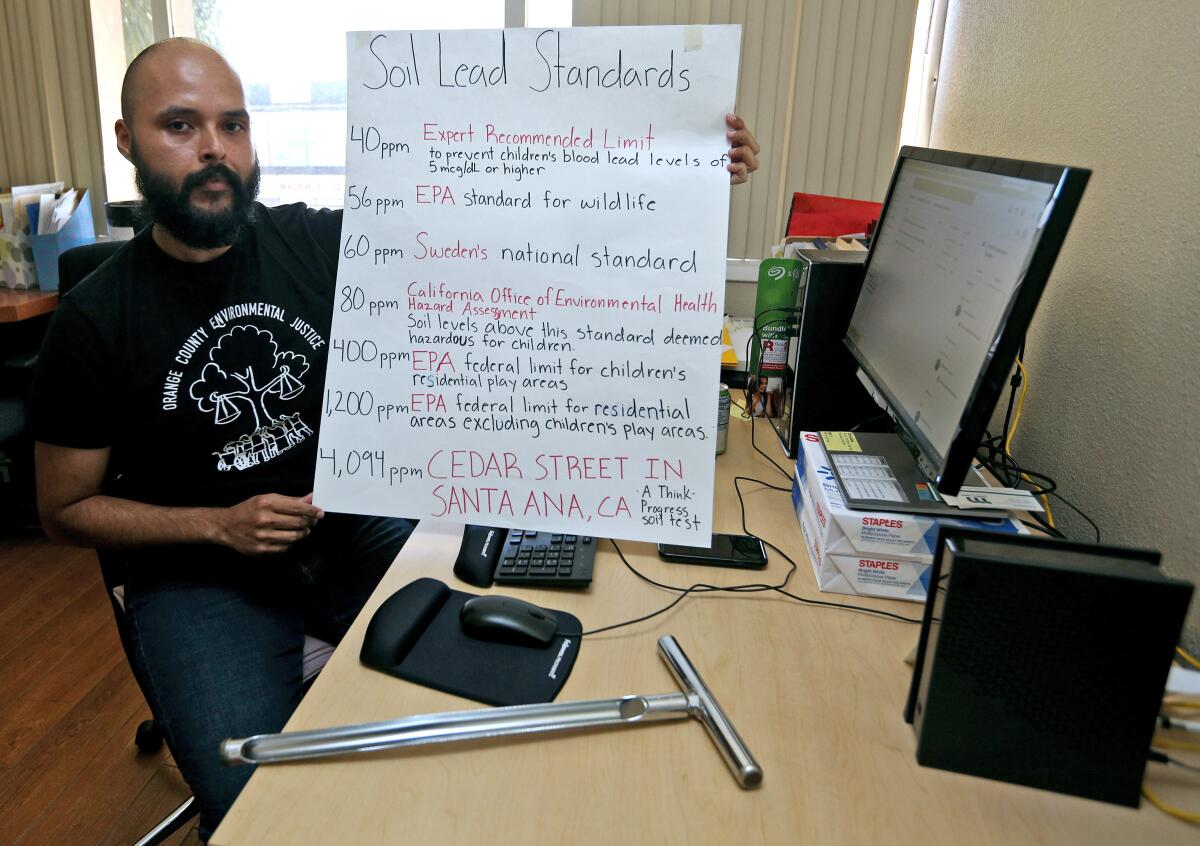Low-income and predominately Latino neighborhoods in Santa Ana affected by toxic lead, report says

- Share via
There are potentially unhealthy levels of lead in low-income and predominately Latino neighborhoods in Santa Ana, a new report finds.
Local organization Orange County Environmental Justice partnered with UC Irvine and other community members over the last three years for the study.
The coalition analyzed more than 1,500 soil samples from more than 500 locations, finding that the samples ranged from 11.4 to 2,687 parts per million, with an average soil sample of 123.1 ppm.
The California Office of Environmental Health Hazard Assessment considers anything above 80 ppm in a residential area as hazardous to health. About half of the soil samples exceeded the California safety recommendation.
“This is of the utmost urgency,” said Enrique Valencia, project director of Orange County Environmental Justice. “We are sheltering in places that may have high levels of lead toxicity. We are doing everything out of our homes, so we are confined to places that may be contaminated, and that’s especially concerning for our children ... This is a toxin that is dangerous to humans at any age. We can’t afford to ignore the science anymore.”
In analyzing how lead disproportionately affects lower-income communities, the researchers found that there was an inverse correlation between income levels and the presence of lead in the community. Soil samples collected in neighborhoods with median household incomes below $50,000 had 440% higher lead levels than communities with a median household income of $100,000, and 70% higher lead concentrations when compared to neighborhoods with median household incomes between $50,000 and $100,000.
Despite a presence of nearly half a century in the U.S., Cambodians and Vietnamese continue to struggle with social inequities, including access to culturally sensitive healthcare. Orange County is home to approximately 195,000 Vietnamese and 7,000 Cambodian residents.
The report also found that thousands of children in Santa Ana are particularly at risk.
The researchers found that neighborhoods housing more than 28,000 children had maximum lead concentrations exceeding 80 ppm, and 12,000 of those children were in neighborhoods with lead concentrations above 400 ppm, the Environmental Protection Agency’s recommendation for play areas.
Children who are exposed to lead can develop a number of neurological issues, including smaller brain volume, lower working memory and processing speed, more limited perceptual reasoning, poor school performance and asthma, the study says.
Adults who are exposed to high levels of lead can suffer cardiovascular issues, renal problems, osteoporosis and cognitive deficiencies.
“We have not had any recent contact with the researchers, but we will review the report,” Santa Ana spokesman Paul Eakins said when reached for comment. “The health and well-being of Santa Ana residents is of utmost importance. The city is currently in the process of a draft General Plan update that includes an Environmental Justice Policy Framework that lists among its priorities reducing the community’s exposure to pollution.”
Valencia said they have tried to offer their help to the city but have not received a reply.
Valencia believes it would be best to include lead remediation efforts in the city’s general plan update, which includes a section on environmental justice.
“You know, my sense is that there’s a hesitancy to work on this issue,” Valencia said. “Even though we know that Think Progress has been investigating the issue since 2017. Even then the city hasn’t hadn’t really stepped up to address the issue.
“I think it’s a matter of this City Council’s priorities. From what we’ve seen, they aren’t prioritizing the issues that are impacting the most vulnerable communities.”
The researchers started in 2017, when Valencia joined forces with the Santa Ana-based community group Jóvenes Cultivando Cambios and Alana LeBron, a UC Irvine assistant professor of public health and Chicano/Latino studies.
Orange County restaurants, movie theaters, places of worship and museums can resume indoor operations at 25% capacity, while fitness centers must be limited to 10% capacity.
The impetus was a detailed investigation of the lead crisis in Santa Ana by former ThinkProgress investigative reporter Yvette Cabrera.
For the investigative series, Cabrera found hazardous lead levels after testing more than 1,000 soil samples from homes and other public areas around Santa Ana.
Valencia’s coalition decided to expand on her work.
“We see this as part of the process of building a movement,” LeBron said in an earlier interview. “Our goal is a lead-free Santa Ana.”
LeBron said lead likely found its way into soil from historically leaded gasoline and paint.
Valencia said the group recently got a grant from the California EPA to do additional testing to determine the sources of the lead.
The federal government banned consumer uses of lead-containing paint in 1978. But, LeBron said census data shows the majority of houses in Santa Ana were built prior to that ban.
“Compared to the rest of the county, Santa Ana housing stock is significantly older and much more likely to have lead paint,” LeBron said.
LeBron said poorer neighborhoods can be more at risk for a number of reasons, including that residents may not have access to the resources to remediate the issue.
“Communities of color and low-income residents get funneled into housing markets that are not maintained or remediated,” LeBron said.
All the latest on Orange County from Orange County.
Get our free TimesOC newsletter.
You may occasionally receive promotional content from the Daily Pilot.





